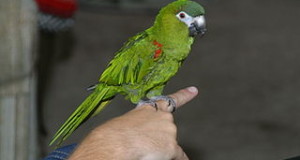The trimming of flight feathers is often touted as an important first step in training parrots and other birds, but the process has many other important implications that should not be overlooked. Parrots, finches, softbills, quails – and, as you’ll see, Saurus Cranes – each present different considerations, as do your reasons for keeping the birds and the situations in which they are housed.
Age Considerations
It is true that, in general, birds with clipped wings are easier to work with and train than are those capable of flight. This is the most common reason that owners trim flight feathers, and the fact that the feathers will grow back does seem to provide an “insurance policy” of sorts, in case all does not go as planned.
However, timing is critical and mistakes are not always reversible, even though the feathers will re-grow. For example, flight feathers should never be clipped before your pet has learned to fly. Doing so will hamper the proper development of important pectoral (flight) muscles, and will limit the bird’s ability to learn to fly later in life – there seems to be a critical window of time for both these processes.
Giant Crane Loose in New York City
 A serious concern that I’ve run across regarding wing-clipped birds is the failure of owners to realize just when the feathers have grown in enough to allow for flight. This was brought home to me very directly many years ago when I was working with Saurus Cranes (Grus antigone) housed in an open-topped outdoor exhibit at the Bronx Zoo.
A serious concern that I’ve run across regarding wing-clipped birds is the failure of owners to realize just when the feathers have grown in enough to allow for flight. This was brought home to me very directly many years ago when I was working with Saurus Cranes (Grus antigone) housed in an open-topped outdoor exhibit at the Bronx Zoo.
One summer evening, while working late to accommodate an after-hours event, I looked up at the setting sun just in time to see a Saurus Crane sailing gracefully over the pastel-hued roofs of the South Bronx! Standing nearly 6 feet in height, and with a wingspan to match, this tallest of the world’s birds made quite an impressive sight – but not one I was happy to be viewing at that particular time and place! Apparently someone had forgotten to inform the crane that its primary feathers had been clipped 4 months earlier, and that it should therefore remain flightless for quite some time yet!
Further Reading
Please see my article Clipping Flight Feathers – Considerations and Techniques for more info and “how to” advice.
Please check out this National Geographic Video on the magnificent Saurus Crane.
Sarus Crane image referenced from wikipedia and originally posted by J.M.Garg
 That Bird Blog – Bird Care and History for Pet Birds
That Bird Blog – Bird Care and History for Pet Birds



